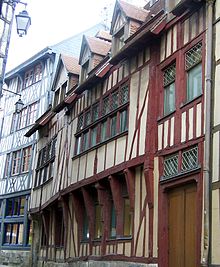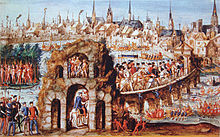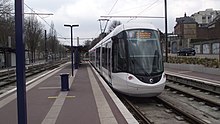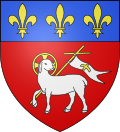Rouen: Difference between revisions
Extended confirmed users 217,264 edits dl, tag |
AWB |
||
| Line 387: | Line 387: | ||
==In fiction and popular culture== |
==In fiction and popular culture== |
||
{{in popular culture|date=May 2017}}{{refimprove|date=May 2017} |
{{in popular culture|date=May 2017}}{{refimprove|date=May 2017}} |
||
===Fine art=== |
===Fine art=== |
||
[[File:RouenCathedral Monet 1894.jpg|thumb|Rouen Cathedral, Full Sunlight, by [[Claude Monet]], 1894.]] |
[[File:RouenCathedral Monet 1894.jpg|thumb|Rouen Cathedral, Full Sunlight, by [[Claude Monet]], 1894.]] |
||
| Line 420: | Line 421: | ||
* The ''[[Rouen-Les-Essarts]]'' Grand Prix circuit is featured in ''[[Grand Prix Legends]]'', [[Project CARS]], and ''[[RFactor]]''. |
* The ''[[Rouen-Les-Essarts]]'' Grand Prix circuit is featured in ''[[Grand Prix Legends]]'', [[Project CARS]], and ''[[RFactor]]''. |
||
* The PC adventure game [[Touché: The Adventures of the Fifth Musketeer]] starts in Rouen. |
* The PC adventure game [[Touché: The Adventures of the Fifth Musketeer]] starts in Rouen. |
||
* [[Time Crisis#Protagonists|Evan Bernard]], a playable character from ''[[Time Crisis 4]]'', is said to come from Rouen. |
* [[Time Crisis#Protagonists|Evan Bernard]], a playable character from ''[[Time Crisis 4]]'', is said to come from Rouen. |
||
==Heraldry== |
==Heraldry== |
||
Revision as of 18:48, 10 May 2017
Rouen | |
|---|---|
Seine River. Middle left: Maritime museum. Centre: The Great Clock. Middle right: Gustave-Flaubert Bridge. Bottom: Rouen Cathedral . | |
36th in France | |
| • Density | 5,200/km2 (14,000/sq mi) |
| • Urban (2010) | 494,382 |
| • Urban density | 1,100/km2 (2,900/sq mi) |
| • Metro (2010) | 650,000 |
| • Metro density | 360/km2 (940/sq mi) |
| Time zone | UTC+01:00 (CET) |
| • Summer (DST) | UTC+02:00 (CEST) |
| INSEE/Postal code | 76540 / |
| Website | www.rouen.fr |
| 1 French Land Register data, which excludes lakes, ponds, glaciers > 1 km2 (0.386 sq mi or 247 acres) and river estuaries. | |
Rouen (French pronunciation:
The population of the metropolitan area (in French: agglomération) at the 2007 census was 532,559, with the city proper having an estimated population of 110,276. People from Rouen are known as Rouennais.
Administration
Rouen and its metropolitan area of 70 suburban communes form the
History
It has been suggested that this section be split out into another article titled History of Rouen. (Discuss) (November 2015) |
Rouen was founded by the Gaulish tribe of Veliocasses, who controlled a large area in the lower Seine valley, which today retains a trace of their name as the Vexin. The Gauls named the settlement Ratumacos[1] and the Romans called it Rotomagus.[2] Roman Rotomagus was the second city of Gallia Lugdunensis, after Lugdunum (Lyon). After the reorganization of the empire by Diocletian, Rouen became the chief city of the divided province of Gallia Lugdunensis II and reached the peak of its Roman development, with an amphitheatre and thermae, the foundations of which remain today. In the 5th century, it became the seat of a bishopric and later a capital of Merovingian Neustria.
The Middle Ages
After the first
During the early 12th century the city's population reached 30,000.[4] In 1150, Rouen received its founding charter, which permitted self-government. During the 12th century, Rouen was probably the site of a Jewish yeshiva. At that time, about 6,000 Jews lived in the town, comprising about 20% of the total population[citation needed]. The well-preserved remains of a medieval Jewish building, that could be a yeshiva, were discovered in the 1970s under the Rouen Law Courts.
In 1200, a fire destroyed part of Rouen's Romanesque cathedral, leaving just St Romain's tower, the side porches of its front, and part of the nave. New work on the present Gothic cathedral of Rouen began, in the nave, transept, choir, and the lowest section of the lantern tower. On 24 June 1204, Philip Augustus entered Rouen and annexed Normandy to the Royal Demesne. The fall of Rouen meant the end of Normandy's vassal state status. He demolished the Norman castle and replaced it with his own, the Château Bouvreuil, built on the site of the Gallo-Roman amphitheatre.[5]
A textile industry developed based on wool imported from England, competing with the northern County of Flanders and the Duchy of Brabant. The city found its market niche in the Champagne fairs. Rouen also depended on the river traffic of the Seine for its prosperity. Wine and wheat were exported to England, with tin and wool received in return.
In the late 13th century urban strife threatened the city: in 1291, the mayor was assassinated and noble residences in the city were pillaged. Philip IV restored order and suppressed the city's charter and the city's lucrative monopoly on river traffic, but he was quite willing to allow the Rouennais to repurchase their former liberties in 1294. In 1306, he decided to expel the Jewish community of Rouen, which then numbered some five or six thousand in the city of 40,000 people.[6]

In 1389, another

During the
Rouen became the capital city of English power in occupied France and when the
The king of France Charles VII recaptured the town in 1449, 18 years after the death of Joan of Arc and after 30 years of English occupation. In that same year the young Henry VI was crowned King of England and France in Paris before coming to Rouen where he was acclaimed by the crowds.
The Renaissance Period
The naval dockyards, where activity had been slowed by the 100 years war, became busy again as did the church of Saint-Maclou, which had been founded under English occupation The nave of the church of Saint Ouen was completed at last. The salle des pas-perdus (a sort of waiting room or ante-room) of the present law courts was built during this time. The whole building was built in a flamboyant style into which the first decorative elements typical of the Renaissance style right at the beginning of the 16th century had been incorporated.
At that time Rouen was the fourth most populous city in the realm, after Paris, Marseille and Lyon. Rouen was also one of the Norman cradles of artistic Renaissance, in particular the one under the patronage of the archbishops and financiers of the town.
The city's economic upturn at the end of the 15th century was mainly due to the emergence of the cloth industry, but also partly due to the development of the silk industry and metallurgy. The fishermen of Rouen went as far afield as the Baltic to fish for herrings. Salt was imported from
At the beginning of the 16th century Rouen became the main French port through which trade was conducted with Brazil, principally for the import of cloth dyes. By 1500 ten printing presses had been installed in the city following the installation of the first sixteen years earlier.
The Wars of Religion
In the years following 1530, part of the population of Rouen embraced
In 1550, King
From 1560 onwards tensions rose between the Protestant and Catholic communities, and the

At this juncture the Protestant town authorities requested help from Queen
The news of the
The town was attacked on several occasions by
The Classical Age
The permanent exchequer of Normandy, which had been installed in Rouen in 1499 by George of Amboise, was transformed into a regional administrative assembly by Francis I in 1515 and up to the time of the Revolution was the administrative centre of the region. It had judicial, legislative and executive powers in Norman affairs and was only subordinate to the Privy Council. It also had power to govern French Canada. The 16th and the 18th centuries brought prosperity to the city through the textile trade and the increased use of port facilities. In 1703 the Norman Chamber of Commerce was formed. Although it did not have a university, Rouen became an important intellectual centre by reason of its reputed schools of higher learning. In 1734, a school of surgery (second only to that of Paris founded in 1724) was founded. In 1758 a new hospital was opened to the west of the town which replaced the old medieval one which had become too small.
19th, 20th and 21st centuries
During the Franco-Prussian War of 1870-1871, Rouen was occupied by the Prussians.
During the
Rouen was heavily damaged during World War II - approximately 45% of the city was destroyed. In June 1940 the area between the
Climate
Rouen has an oceanic climate (Cfb in the Koeppen climate classification).
| Climate data for Rouen (1981–2010 averages) | |||||||||||||
|---|---|---|---|---|---|---|---|---|---|---|---|---|---|
| Month | Jan | Feb | Mar | Apr | May | Jun | Jul | Aug | Sep | Oct | Nov | Dec | Year |
| Record high °C (°F) | 14.7 (58.5) |
18.9 (66.0) |
22.3 (72.1) |
26.4 (79.5) |
30.0 (86.0) |
34.2 (93.6) |
37.9 (100.2) |
38.1 (100.6) |
31.3 (88.3) |
28.0 (82.4) |
20.3 (68.5) |
15.6 (60.1) |
38.1 (100.6) |
| Mean daily maximum °C (°F) | 6.4 (43.5) |
7.3 (45.1) |
10.8 (51.4) |
13.7 (56.7) |
17.3 (63.1) |
20.3 (68.5) |
22.8 (73.0) |
22.8 (73.0) |
19.5 (67.1) |
15.0 (59.0) |
9.9 (49.8) |
6.6 (43.9) |
14.4 (57.9) |
| Mean daily minimum °C (°F) | 1.1 (34.0) |
1.1 (34.0) |
3.2 (37.8) |
4.7 (40.5) |
8.1 (46.6) |
10.7 (51.3) |
12.8 (55.0) |
12.8 (55.0) |
10.4 (50.7) |
7.8 (46.0) |
4.1 (39.4) |
1.7 (35.1) |
6.6 (43.9) |
| Record low °C (°F) | −17.1 (1.2) |
−13.4 (7.9) |
−10.4 (13.3) |
−4.8 (23.4) |
−2.2 (28.0) |
1.1 (34.0) |
5.9 (42.6) |
5.0 (41.0) |
2.1 (35.8) |
−3.2 (26.2) |
−8.3 (17.1) |
−11.3 (11.7) |
−17.1 (1.2) |
| Average precipitation mm (inches) | 76.3 (3.00) |
60.4 (2.38) |
67.1 (2.64) |
59.2 (2.33) |
74.3 (2.93) |
63.7 (2.51) |
68.9 (2.71) |
65.1 (2.56) |
65.5 (2.58) |
83.5 (3.29) |
76.8 (3.02) |
90.9 (3.58) |
851.7 (33.53) |
| Average precipitation days | 13.0 | 10.3 | 11.9 | 10.7 | 11.8 | 9.5 | 9.4 | 9.0 | 9.7 | 12.4 | 13.0 | 13.0 | 133.6 |
| Average snowy days | 4.7 | 4.2 | 3.3 | 1.8 | 0.2 | 0.0 | 0.0 | 0.0 | 0.0 | 0.0 | 1.7 | 3.4 | 19.3 |
| Average relative humidity (%)
|
90 | 86 | 83 | 78 | 79 | 80 | 79 | 80 | 84 | 89 | 90 | 91 | 84.1 |
| Mean monthly sunshine hours | 58.6 | 74.5 | 117.4 | 158.0 | 182.8 | 202.2 | 199.2 | 191.8 | 156.1 | 107.8 | 60.0 | 49.2 | 1,557.5 |
| Source 1: Météo France[10][11] | |||||||||||||
| Source 2: Infoclimat.fr (humidity and snowy days, 1961–1990)[12] | |||||||||||||
Main sights

Rouen is known for its
The Gros Horloge is an astronomical clock dating back to the 16th century. [citation needed] It is located in the Gros Horloge street.
Other famous structures include Rouen Castle, whose keep is known as the tour Jeanne d'Arc, where Joan of Arc was brought in 1431 to be threatened with torture (contrary to popular belief, she was not imprisoned there but in the since destroyed tour de lady Pucelle); the Church of Saint Ouen (12th–15th century); the Palais de Justice, which was once the seat of the Parlement (French court of law) of Normandy; the Gothic Church of St Maclou (15th century); and the Museum of Fine Arts and Ceramics which contains a splendid collection of faïence and porcelain for which Rouen was renowned during the 16th to 18th centuries. Rouen is also noted for its surviving half-timbered buildings.
There are many museums in Rouen: the Musée des Beaux-Arts de Rouen, an art museum with pictures of well-known painters such as Claude Monet and Géricault; the Musée maritime fluvial et portuaire, a museum on the history of the port of Rouen and navigation; Musée des antiquités,[13] an art and history museum with local works from the Bronze Age through the Renaissance, the Musée de la céramique and the Musée Le Secq des Tournelles.
The Jardin des Plantes de Rouen is a notable botanical garden once owned by Scottish banker John Law dated from 1840 in its present form. It was the site of Élisa Garnerin's parachute jump from a balloon in 1817.
In the centre of the Place du Vieux Marché (the site of Joan of Arc's pyre)
Rouen was also home to the French Grand Prix, hosting the race at the nearby Rouen-Les-Essarts track sporadically between 1952 and 1968. In 1999 Rouen authorities demolished the grandstands and other remnants of Rouen's racing past. Today, little remains beyond the public roads that formed the circuit.

Transport

Mainline trains operate from

City transportation in Rouen consists of a tram and a bus system. The
Rouen has its own airport, serving major domestic destinations as well as international destinations in Europe.
The
Education
The main schools of higher education are the
Performing arts
The main opera company in Rouen is the Opéra de Rouen - Normandie. The company performs in the Théâtre des Arts, 7 rue du Docteur Rambert. The company presents opera, classical and other types of music, both vocal and instrumental, as well as dance performances.[16] Every five years, the city hosts the large maritime exposition, L'Armada.[17]
Notable people






Rouen was the birthplace of:
- Edward IV(1442–1483), King of England
- Thomas Aubert (b. 1500s), explorer
- Guillaume Guéroult (1507–1569), poet
- François de Civille (1537–1610), military commander
- Isaac Oliver (c. 1560 – 1617), French-born English painter
- Guy de la Brosse(1586–1641), botanist and pharmacist
- Antoine Girard de Saint-Amant (1594–1661), poet
- Louise Levesque (1703–1745), playwright, poet
- Alphonse Maille (1813–1865) botanist
- Samuel Bochart (1599–1667), Protestant theologian
- Pierre Corneille (1606–1684), tragedian
- Guillaume Couture (1617–1701), lay missionary and diplomat
- Adrien Auzout (1622–1691), astronomer
- Thomas Corneille (1625–1709), dramatist, brother of Pierre Corneille
- Noel Alexandre(1630–1724), theologian and ecclesiastical historian
- Marie Champmeslé (1642–1698), actress
- René-Robert Cavelier, Sieur de La Salle (1643–1687), explorer
- Gabriel Daniel (1649–1728), Jesuit historian
- Nicolas Lemery (1645–1715), chemist
- Anne Mauduit de Fatouville (17th–1715), playwright
- Jean Jouvenet (1647–1717), painter
- Nicolas Gueudeville (1652–1721), Catholic writer
- Jacques Basnages(1653–1723), Protestant theologian
- Bernard le Bovier de Fontenelle(1657–1757), author, nephew of Pierre Corneille
- Pierre Antoine Motteux(1663–1718), French-born English dramatist
- Pierre Dangicourt (1664–1727), mathematician
- François Blouet de Camilly (1664–1723), Catholic Archbishop
- Pierre François le Courayer (1681–1776), theologian
- François d'Agincourt (1684–1758), composer
- Jean II Restout(1692–1768), painter
- Jeanne-Marie Leprince de Beaumont (1711–1780), novelist
- Jacques-François Blondel (1705–1774), architect
- Marie-Madeleine Hachard (1708–1760), nun and abbess
- Jacques Duphly (1715–1789), composer
- Pierre-Antoine Guéroult (1749–1816), scholar
- François-Adrien Boïeldieu(1775–1834), composer
- Pierre Louis Dulong (1785–1838), physicist and chemist
- Théodore Géricault (1791–1824), painter
- Armand Carrel (1800–1836), writer
- Pierre Adolphe Chéruel (1809–1891), historian
- Gustave Flaubert (1821–1880), novelist
- Joseph-Henri Altès (1826–1895), flautist and pedagog
- Eugène Ketterer (1831–1870), composer
- Eugène Caron (1834–1903), opera singer
- Maurice Leblanc (1864–1941), novelist
- Charles Nicolle (1866–1936), bacteriologist
- Georges Guillain (1876–1961), neurologist
- Robert Antoine Pinchon (1886–1943), painter
- Marcel Dupré (1886–1971), composer
- Marcel Duchamp (1887–1968), artist
- Philippe Étancelin (1896–1981), race car driver
- Roger Apéry (1916–1994), mathematician
- Jacques Rivette (1928–2016), film director
- Jean-Yves Lechevallier (b. 1946), sculptor
- Anny Duperey (b. 1947), actress and novelist
- President of the French Republic
- Élise Lucet (b. 1963), journalist
- Stéphan Caron (b. 1966), swimmer
- Karin Viard (b. 1966), actress
- Céline Minard (b.1969), writer
- David Trezeguet (b. 1977), footballer
- Nathalie Péchalat (b. 1983), ice dancer
- Amaury Vassili (b. 1989), singer
- Alexis Gougeard (b. 1993), cyclist
- Frederic Cissokho, footballer
- Dominique Lokoli, footballer
- Ian Mahinmi, basketball player
- Christophe Mendy, boxer
- Darnel Situ, footballer
- Moussa Sylla, basketball player
- Fayçal Fajr, footballer
International relations
Twin towns – Sister cities
Rouen is
 Gdańsk, Pomeranian Voivodeship, Poland, since 1992[18]
Gdańsk, Pomeranian Voivodeship, Poland, since 1992[18] Cleveland, Ohio, United States of America[19]
Cleveland, Ohio, United States of America[19] Hanover, Lower Saxony, Germany[20]
Hanover, Lower Saxony, Germany[20] Norwich, Norfolk, England, United Kingdom[21]
Norwich, Norfolk, England, United Kingdom[21] Ningbo, China
Ningbo, China Salerno, Salerno, Campania, Italy, since 2003
Salerno, Salerno, Campania, Italy, since 2003 Wejherowo, Pomeranian Voivodeship, Poland
Wejherowo, Pomeranian Voivodeship, Poland Jeju City, South Korea, since 2004
Jeju City, South Korea, since 2004
In fiction and popular culture
This article needs additional citations for verification. (May 2017) |
Fine art

Sculpture
During the second half of the 20th century, several sculptures by Jean-Yves Lechevallier were erected in the city.

Literature
- The character Erik, The Opera Ghost of Gaston Leroux's novel The Phantom of the Opera, was supposedly born "in a small town not far from Rouen".[22]
- Rouen plays a major part in the Flaubert novel Madame Bovary.
- Maupassant, a student of Flaubert, wrote a number of short stories based in and around Rouen.
- In book two of The Strongbow Saga, the Vikings invade and conquer Ruda, also known as Rouen, and make it their base in Frankia.
The Rouen area is an integral part of the work of French writer Annie Ernaux.
- May Wedderburn Cannan wrote of Rouen in her 1915 poem on World War I "Rouen".
Music
- Referenced to in Puccini's one-act opera, Il tabarro. In the opera, Luigi asks his boss, the barge owner Michele, to drop him off in Rouen because he is secretly in love with Michele's wife, Giorgetta and cannot stand to share her with him.
- The British rock band Supergrass named their fifth studio album Road to Rouen, punning on an Anglicised pronunciation of the city's name.
- French band Les Dogs formed in Rouen in 1973.
- English rock band Arcane Roots named a song on their EP Left Fire 'Rouen'.
Film
The 2000 film
Video games
- The game Call of Duty 3 features a map set in Rouen.
- In the Raphael, a playable character, is explained as being born in Rouen.
- Rouen appears as an important location to protagonist Alice Elliot in the game Shadow Hearts.
- The Rouen-Les-Essarts Grand Prix circuit is featured in Grand Prix Legends, Project CARS, and RFactor.
- The PC adventure game Touché: The Adventures of the Fifth Musketeer starts in Rouen.
- Evan Bernard, a playable character from Time Crisis 4, is said to come from Rouen.
Heraldry
 |
The arms of Rouen are pascal lamb, haloed and contorny, holding a banner argent charged with a cross Or, and on a chief azure, 3 fleurs de lys Or
This may be rendered, "On a red background a haloed white pascal lamb looking back over its shoulder (contorny) holds a white banner bearing a gold cross; above, a broad blue band across the top bears 3 gold fleurs de lis".
|
See also
- Archbishopric of Rouen
- Saint Ouen (catholic saint)
- The works of Maxime Real del Sarte
- Two of the statues on the Pont Boieldieu in Rouen were sculpted by Jean-Marie Baumel
References
- toponymicsuffix signifying "plain".
- Notitia dignitatum; other variants: Ratomagos (Ptolemy, Geography), Ratomagos (Antonine Itinerary, Tabula Peutingeriana).
- ^ Recorded in the chronicle of Fontenelle Abbey.
- ISBN 9781482705744. Retrieved 10 October 2014.
- Viollet-le-Duc, the castle was destroyed at the end of the 15th century, its stones used for other buildings.
- ISBN 9780415080712. Retrieved 10 October 2014.
- ^ Bill Marshall, Cristina Johnston, France and the Americas: culture, politics, and history Volume 3, p. 185
- ISBN 9780674038738. Retrieved 10 October 2014.
- ^ Beard, 31. See 32, Fig. 7 for a contemporary depiction of Henri's "Romanised" procession.
- ^ "Données climatiques de la station de Rouen" (in French). Meteo France. Retrieved 5 January 2016.
- ^ "Climat Haute-Normandie" (in French). Meteo France. Retrieved 5 January 2016.
- ^ "Normes et records 1961-1990: Rouen-Boos (76) - altitude 151m" (in French). Infoclimat. Retrieved 5 January 2016.
- ^ ": : : Musées en Haute-Normandie : : :". Musees-haute-normandie.fr. Archived from the original on 16 November 2006. Retrieved 4 February 2014.
{{cite web}}: Unknown parameter|dead-url=ignored (|url-status=suggested) (help) - ^ "Rouen . visite-de-rouen.com . Place du Vieux Marché". Visite-de-rouen.com. Retrieved 16 September 2011.
- ^ fr:Église Sainte-Jeanne-d'Arc de Rouen
- ^ Opéra de Rouen - Haute-Normandie official web site.
- ^ Rouen - Armada website.
- ^ "Gdańsk Official Website: 'Miasta partnerskie'" (in Polish and English). 2009 Urząd Miejski w Gdańsku. Retrieved 11 July 2009.
{{cite web}}: External link in|publisher= - ^ "Sister Cities International (SCI)". Sister-cities.org. Retrieved 21 April 2013.
- ^ "Hanover – Twin Towns" (in German). 2007–2009 Hannover.de – Offizielles Portal der Landeshauptstadt und der Region Hannover in Zusammenarbeit mit hier.de. Retrieved 17 July 2009.
{{cite web}}: External link in|publisher= - ^ "British towns twinned with French towns". Archant Community Media Ltd. Retrieved 11 July 2013.
- ^ "The Phantom of the Opera by Gaston Leroux - Free Ebook". gutenberg.org. Retrieved 16 August 2015.
External links
- Official website Template:Fr icon
- Rouen Tourist Board Template:Fr icon
- Objectif Rouen: Pictures and descriptions of the most famous monuments Template:Fr icon
- The Catholic Encyclopedia 1908 detailed ecclesiastical history Template:En icon
- Rouen, Its History and Monuments, by Théodore Licquet, 1840, from Project Gutenberg Template:En icon


